Cold water immersion, which is usually referred to as either cold plunging or ice bathing, is an excellent way to reduce inflammation, recover quicker from high-intensity workouts, better manage stress and anxiety, become more resilient and more.
In this article, I’ll discuss the 10 most significant health benefits of the practice, with links to scientific research that explains the underlying mechanisms of cold water therapy in even greater detail.
- Increases energy levels
- Triggers hormesis and improves resilience
- Speeds up physical recovery
- Helps you manage stress and improves your discipline
- Boosts your mood
- Improves your cardiovascular health
- May improve your sleep
- Helps burn fat and improves your insulin sensitivity
- Strengthens your immune system
- Offers neurocognitive benefits
I’ve been plunging for years, so throughout the article, I’ll also tell you about my experience (including some tips for getting the most out of your plunging sessions). And I’ll briefly outline a few of the potential side effects.
Increases Energy Levels
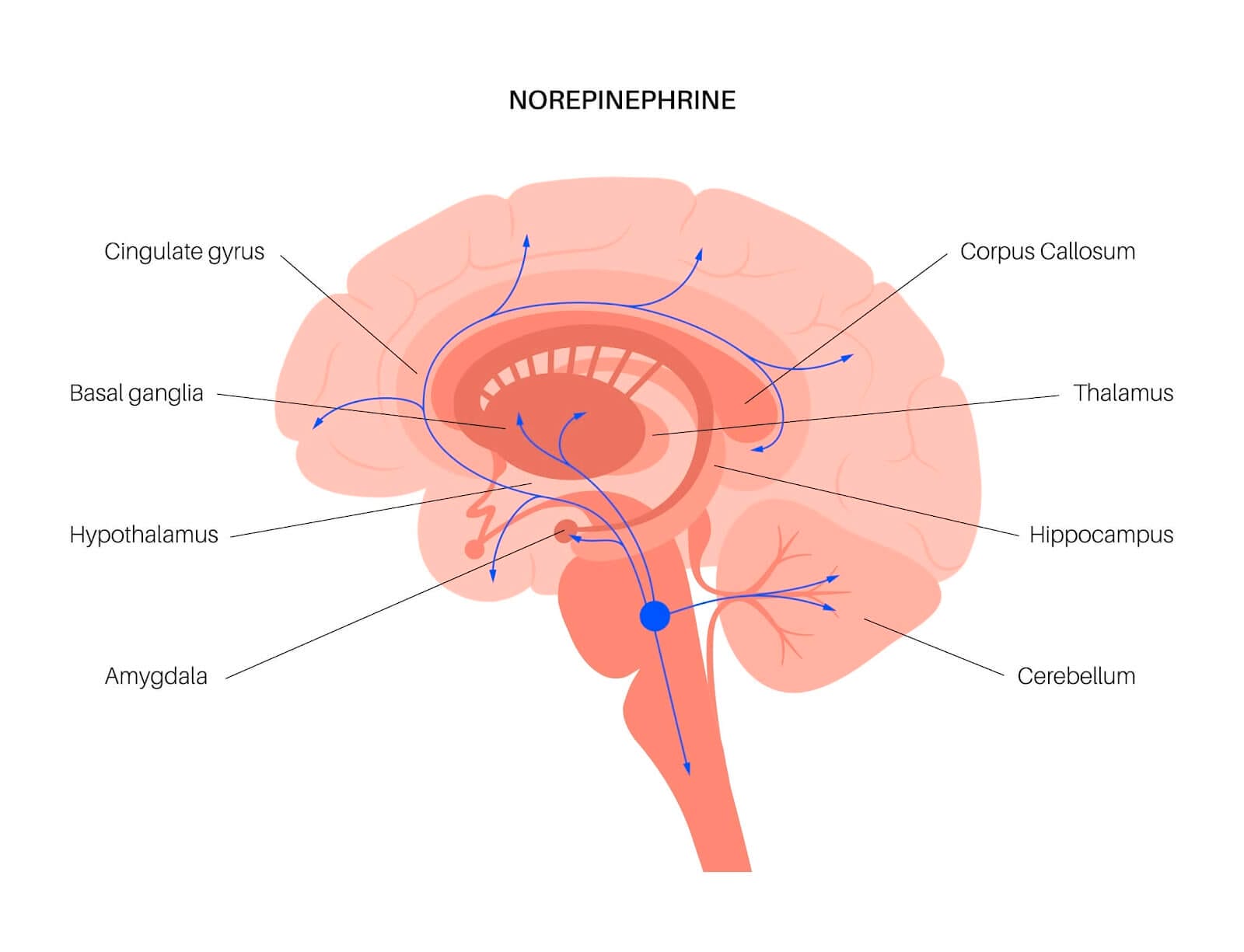
According to Stanford University professor of neurobiology Dr. Andrew Huberman, deliberate cold exposure causes an increase in energy levels by triggering the release of certain energy-regulating hormones, such as epinephrine and norepinephrine. (Other studies have confirmed that the secretion of norepinephrine increases during cold exposure.)
This occurs because exposure to very low temperatures activates your body’s sympathetic nervous system, which is responsible for helping you cope with stress. As part of the body’s stress response, several metabolic pathways are activated that increase your alertness and make glucose available for immediate energy. Check out my podcast episode with Ulrich Dempfle on reduced excretion high-intensity interval training for more information on what happens inside the body during an acute stress response.
What’s interesting is that those energy-boosting hormones remain elevated after you get out of the plunge — even though the stress has subsided and the sympathetic branch has calmed down.
Anecdotally, I asked friends and family who are into cold plunging how long they felt elevated energy levels after cold exposure, and the consensus was that the effect lasts for several hours. That aligns with my own experience, which is why I prefer to jump into my cold plunge in the morning and no later than early afternoon (so as not to disrupt my sleep).
Triggers Hormesis and Improves Resilience
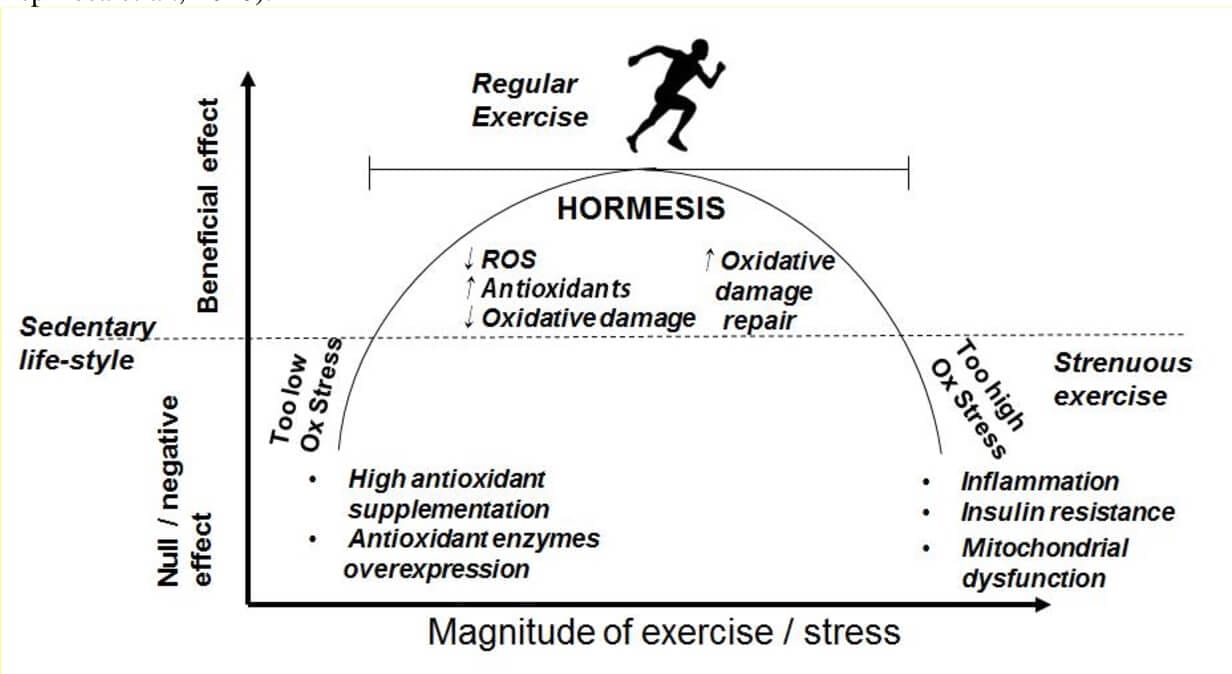
Hormesis is a process in which exposure to mild stressors, like cold temperatures, triggers beneficial adaptive responses in the body. This has been shown to improve resilience, metabolism and overall health.
For instance, cold exposure increases the activity of brown adipose tissue (BAT), which enhances thermogenesis and energy expenditure, contributing to improved metabolic health and weight management.
Additionally, cold exposure can enhance the body’s overall stress resilience, leading to better management of other stressors, both physical and psychological.
And in studies conducted with rats, cold exposure also stimulated the PGC-1α protein expression which is a key regulator of mitochondrial biogenesis. (In plain English, deliberate cold exposure can trigger the production of new mitochondria in cells, enhancing energy production and overall metabolic function.)
In many ways, your body adapts to frigid temperatures similarly to how it adapts to intense workouts: it’s uncomfortable initially, but as your body adapts, it becomes stronger.
The researchers Leo Pruimboom and Frits A.J. Muskiet even coined the term “intermittent living” to describe regularly applying certain hormetic stressors (e.g., thirst, hunger and cold exposure) to improve your health and well-being.
The bottom line is that deliberate cold exposure is an excellent way to improve your immune function and metabolic health – two key factors if you want to avoid the metabolic ailments most people suffer from, including cardiovascular disease, cancer, diabetes, autoimmune conditions, cognitive decline and more.
Speeds Up Physical Recovery

When you submerge yourself in ice-cold water, your central nervous system causes the blood vessels in your extremities to constrict, in order to shuttle warm blood to your vital organs. (Your body is shocked by the cold and rushes blood to your heart and other organs as a protection mechanism.) As a result, the circulation in your arms and legs is temporarily restricted.
But when you get out of the cold water, your blood vessels dilate (i.e., get wider than normal), thus triggering increased blood flow to the muscle tissue in your extremities and skin. While that increase in blood flow is temporary, it brings a rapid influx of oxygen and nutrients to the affected tissue, enabling it to heal and repair quicker (leading to increased recovery).
Plus, with this increased blood flow, the metabolic waste products that have accumulated during the period of reduced blood flow (due to vasoconstriction) are more rapidly carried away to be processed and eliminated by organs such as the kidneys and liver.
This is why, if you watch professional sports events or the annual CrossFit Games, you may see athletes take ice baths after or between intense workouts to speed up muscle recovery and reduce delayed onset muscle soreness.
I like taking ice baths after intense CrossFit workouts to boost my energy levels and to feel less sore the day after.
Helps You Manage Stress and Improves Your Discipline
Making the conscious decision to submerge yourself in cold water causes the activation of your sympathetic nervous system — the one that triggers the “fight or flight” response. As a result, cold plunging requires discipline and mental strength, especially if the temperature outside the tub is in freezing territory.
When I took my first cold plunge (see the video above), I wanted to get out of the tub as fast as possible. But because other people were watching (and recording) me, I felt like I had no choice but to calm down by focusing on my breathing.
I got my first Plunge tub delivered in November 2021 — a few months after I had taken my first ice bath and just as temperatures started dropping in Georgia (we had several days in the low 30s at the time).
Let me tell you this: it’s a pure mind game to strip down to your underwear (or bathing suit) in freezing temperatures, knowing that you’re about to feel even colder as you enter the tub. It’s brutal.
The good news is that if you manage to overcome your fear and hesitation, you’ll be mentally stronger from knowing that you have what it takes to succeed in even the toughest conditions.
To this day, I shift all my attention to controlling my breathing when I get into a cold plunge. By doing so, I enable my body to better respond to my overactive sympathetic nervous system and allow my parasympathetic nervous system — the one responsible for resting and digesting — to get back in control.
Being able to down-regulate your sympathetic nervous system means you’re better equipped to manage stress. Over time, that will likely reflect in your heart rate variability (HRV) — a proxy metric that reflects how balanced your autonomic nervous system is.
In other words, learning how to manage the stress of a cold plunge makes you better at managing other types of acute stress as well. And better stress management has a host of positive health outcomes, including improved immune function and lower inflammation.
Dr. Dave Rabin explained in a recent Primal Shift podcast episode that chronic stress is a resource management issue; the more stressed you are, the fewer resources your body has for other tasks, such as healing tissue or fighting pathogens.
To learn more about the significance of heart rate variability, you can read my article outlining the biohacks I’ve used to improve my HRV.
Boosts Your Mood

A 2023 study published in the journal Biology suggests that short-term cold water immersion triggered several positive effects while simultaneously reducing negative variables. For example, participants felt more alert, active and enthusiastic, but less nervous, irritable and upset, after cold-water immersion.
When I emerge from the cold water, I feel like I’ve won another battle against my mind. That feeling of having prevailed yet again sets the tone for the rest of my day and puts me in a better mood.
In addition to that psychological boost, there’s also a biological aspect to cold plunging’s mood-altering benefits: scientists have discovered that deliberate cold exposure “triggers a release of neurotransmitters such as serotonin, cortisol, dopamine, norepinephrine, and β-endorphin, which play a crucial role in emotion regulation, stress regulation, and reward processing.”
Another study, published in 2021, demonstrated that low levels of norepinephrine (NE) are associated with depression and other mental disorders, and concluded that, “therapeutic agents which specifically increase NE activity are effective antidepressants, and there is evidence that those acting simultaneously on 5-HT and NE neurotransmission may have an antidepressant action superior to selective serotonin reuptake inhibitors (SSRIs).”
As I noted in the section above on increased energy levels, there is evidence that cold water immersion increases the secretion of norepinephrine.
Improves Your Cardiovascular Health
Jumping into ice-cold water triggers a cold shock response in most people, leading to a sudden increase in heart and respiratory rate, blood pressure and constriction of blood vessels in the extremities.
Some poorly designed studies (plagued by countess confounding factors) even suggest that “cold exposure could be a critical risk factor for cardiovascular diseases.”
As a result, many people believe that cold water immersion is bad for cardiovascular health. While those with preexisting heart conditions and high blood pressure are advised to consult a knowledgeable healthcare professional before making cold plunging a part of their wellness routine, I consider cold plunging a hormetic stressor that, when leveraged correctly, can make you and your cardiovascular system healthier and more resilient.
A 2024 study published in the Austrian journal Wiener klinische Wochenschrift (Viennese Clinical Weekly) confirmed the beneficial effects of repeatedly applied cold water immersion on subclinical atherosclerosis, inflammation, fat accumulation and lipid profile parameters.
The researchers concluded that repeated cold water immersion led to significant (positive) changes in lipid and non-lipid parameters, a reduction of arterial plaque, a decrease in proatherogenic lipoproteins, decreased liver fat accumulation and improvements in the cardiometabolic profile.
In another study, published in the Human Kinetics Journal, scientists discovered improvements in heart rate variability (HRV) of up to 30.4% in swimmers after daily cold water immersion. This is relevant because HRV is a good proxy for lifetime cardiovascular disease (CVD) risk.
For example, a 2017 study concluded that greater HRV was modestly associated with lower lifetime CVD risk.
Additionally, cold water immersion constricts blood vessels, which temporarily increases blood pressure and reduces blood flow to the extremities but increases blood flow to the vital organs (including the heart).
Once you get out of the cold water and start warming up, your blood vessels dilate and blood flow to your extremities increases. All that back and forth between constriction and dilation is like a workout for your blood vessels, which helps improve cardiovascular health.
May Improve Sleep
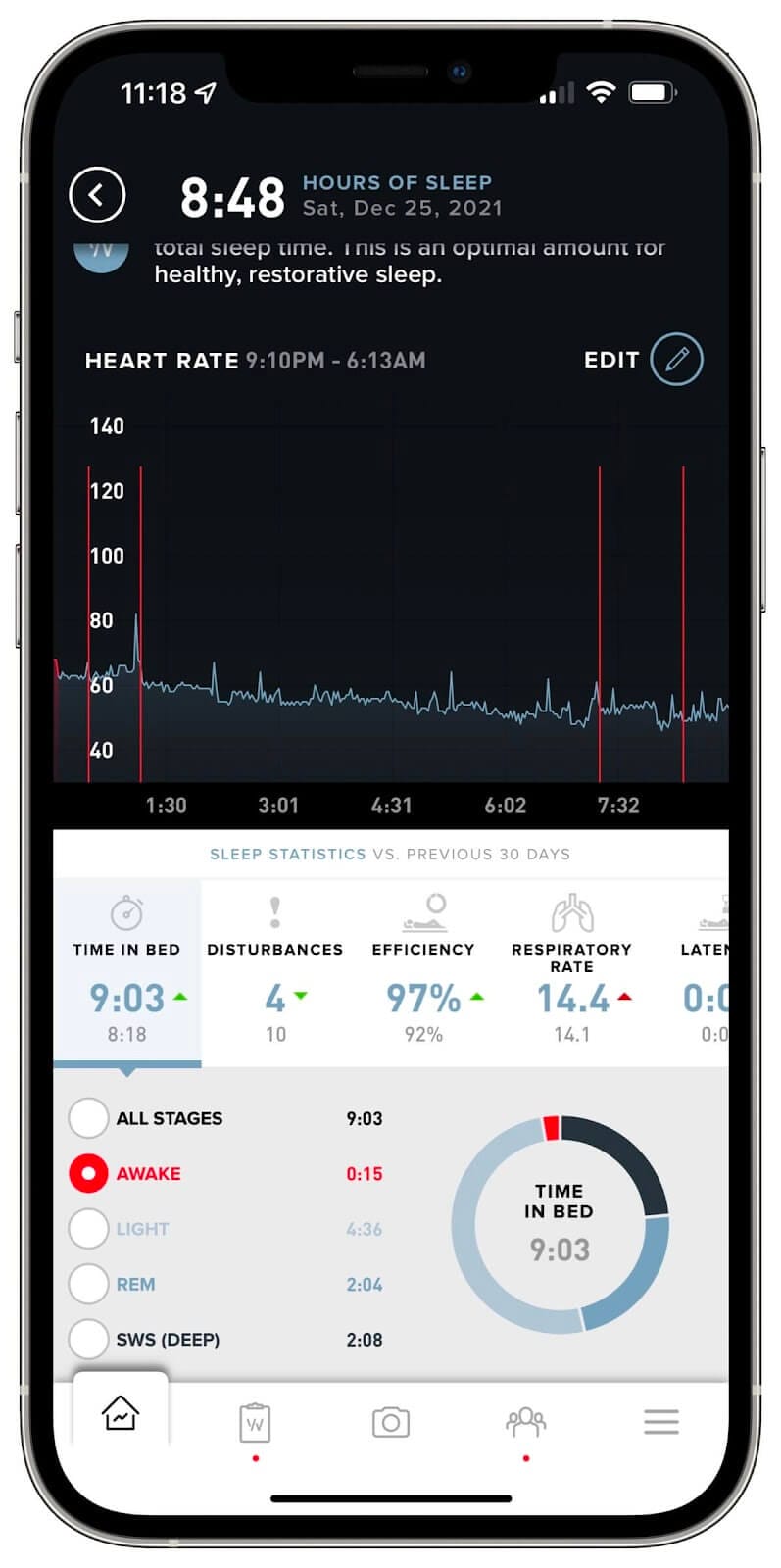
Whether or not cold water immersion improves sleep quality is a hotly debated topic.
One study, published in Frontiers in Sports and Active Living in 2021, found that whole-body cold water immersion positively impacted deep sleep during the first 180 minutes of sleep (the period during which most slow-wave sleep occurs). Another study involving highly-trained swimmers reported improved sleep quality based on heart rate variability (HRV) changes and athlete feedback.
Since I began integrating cold plunging into my regular routine, I’ve noticed a dramatic improvement in my “wake after sleep onset” or WASO (as tracked by my WHOOP strap).
For example, my WASO used to be in the 45 to 60-minute range, but it has decreased to between 15 and 35 minutes. As a result, my sleep has become much more efficient because I spend less time awake in bed.
Based on everything I’ve learned over the past few years of self-experimentation, I firmly believe that cold plunging can be beneficial or detrimental to sleep quality based on the following factors:
- Temperature. If you’re used to cold plunging, moderate temperatures in the 50-60° F range will not send you into fight-or-flight mode. However, submerging yourself into such cold water for 5 to 10 minutes can lower your body’s core temperature, which helps you fall asleep quicker.
- Stress reduction. Many people have trouble falling asleep (or going back to sleep if they wake up in the middle of the night) due to elevated cortisol levels caused by stress. By learning how to better manage stress, you also get better at relaxing. And being in a relaxed state of mind, especially before bedtime, increases your chances of falling asleep quickly and staying asleep.
On the flip side, if you immerse yourself in water so cold that it triggers a massive stress response (or even a panic attack), the elevated cortisol, adrenaline and epinephrine levels will likely prevent you from falling asleep and spending enough time in the restorative phases of sleep.
Additionally, if your core temperature drops too much (e.g., if you start shivering), your body may overcompensate by increasing your core temperature above normal levels, thus also making it more difficult to fall asleep.
That’s why I recommend immersing yourself in colder water during the first half of the day to increase energy levels and improve overall grit and resilience. At night, I recommend slightly warmer temperatures to improve sleep and recovery.
I can’t give specific temperature recommendations because everyone perceives cold temperatures differently, but for me, “cold” means 30-40° F and “warmer” means anything below 55° F.
Helps Burn Fat and Improves Insulin Sensitivity
Exposing your body to cold water activates your brown adipose tissue, also known as brown fat (BAT). This process involves stimulating its ability to burn calories, and produces heat through a process called thermogenesis.
Brown fat contains a high number of mitochondria, which are responsible for its heat-producing function. When activated by cold exposure, BAT can help regulate body temperature and energy expenditure, clear blood glucose and increase insulin sensitivity.
As a result, cold plunging can be an excellent tool for weight loss if combined with a healthy lifestyle that includes an appropriate diet, quality sleep and regular exercise.
Researchers have also discovered that intense shivering (e.g., after prolonged cold exposure) increases dependence on muscle glycogen. While it’s counterproductive for athletic performance if that happens right before a competition, it’s good news if you’re trying to improve your insulin sensitivity.
Just keep in mind that cold water immersion (if done incorrectly) can cause hypothermia. If you don’t know your body well, I recommend getting out of the cold water before you start shivering.
Strengthens Your Immune System

Exposing your whole body to cold water increases the plasma concentration of glutathione. This antioxidant plays a key role in the proper function of t-cell lymphocytes, a type of white blood cell that help protect the body from infections by identifying and destroying infected or cancerous cells and by coordinating the immune response.
Additionally, glutathione activates your natural killer (NK) cells, another type of white blood cell that helps protect the body by directly attacking and killing virus-infected cells and cancerous cells without needing prior exposure to them.
But that’s not all. Scientists in Italy have discovered that cold water swimming induces a significant variation in the blood cell fraction composition.
Specifically, the researchers observed a significant increase in red blood cells, platelet counts and white blood cells (neutrophil granulocytes, lymphocytes and monocytes); while the first two are indirectly related to supporting a healthy immune system, increasing white blood cells boosts the body’s ability to fight infections.
Consequently, cold plunging is one way to boost your immune system and better equip it to fight pathogens, including viruses and bacteria.
Offers Neurocognitive Benefits
Scientists have discovered that cold water immersion triggers the release of cold shock proteins. Those multifunctional RNA/DNA binding proteins have neuroprotective properties that protect cells from stress.
For instance, one type of cold shock protein (RBM3) has been shown to protect neurons by promoting the regeneration of synapses and preventing the accumulation of misfolded proteins, a common feature in neurodegenerative diseases like Alzheimer’s and Parkinson’s.
Research involving mouse models of neurodegenerative diseases demonstrated that increasing levels of RBM3 through cold exposure or direct injection could prevent brain degeneration and improve cognitive function.
What’s more, cold shock proteins protect the cells in your brain and many other parts of your body, including muscle tissue.
Potential Side Effects of Cold Plunging
When done correctly, deliberate cold water immersion is an excellent tool for improving health and well-being. However, some contraindications and potential risks are worth mentioning.
As always, consult with a knowledgeable medical professional before jumping head (or feet) first into cold plunging.
- Untreated hypertension (high blood pressure). Submerging your body in icy water causes your blood vessels to constrict, temporarily increasing your blood pressure. This can be dangerous if you already suffer from high blood pressure. If so, I recommend sauna bathing, another hormetic stressor, instead of cold plunging because it causes your blood vessels to dilate, thus temporarily lowering your blood pressure.
- Cardiovascular disease. If you have a weak heart and aren’t used to extremely cold temperatures, the initial shock response can lead to serious complications. That’s why I recommend starting with cold showers or a water temperature that’s uncomfortable but bearable, so you adapt and learn how to deal with the stress induced by the cold water.
- Hypothermia. If you stay in cold water for too long, you may risk hypothermia and shock. Unless you know what you’re doing, I recommend keeping your cold plunge session length at around 3 to 5 minutes, and getting out when you start shivering (which is an early sign of hypothermia).
- Drowning. Any time you submerge yourself in water, you risk drowning due to accidents (i.e., if you slip on a wet surface, bang your head and become unconscious) or a panic attack. That’s why I recommend always having another adult nearby to assist you in an emergency.
Some people also claim that frequent cold exposure can lead to adrenal fatigue. However, as Thomas P. Seager, PhD from the plunge manufacturer Morozko Forge has pointed out, no credible scientific evidence supports that claim.
Cold Plunging vs. Ice Bathing

You may have noticed that I use the terms “cold plunging” and “ice bathing” interchangeably throughout this article. However, since they might not have the same meaning to everyone, let’s define them.
As far as I’m concerned, cold plunging is an umbrella term used to describe the submersion of your body in cold water. That could mean 32-degree water or 60-degree water — or anything in between. On the other hand, ice bathing typically refers to submerging yourself in water that’s cold enough for ice to form (around 32 to 33 degrees Fahrenheit).
In general, I’d argue that the colder the water is, the more benefit you get. However, it all depends on your tolerance level. If you’ve never taken an ice bath or cold plunge, my recommendation is to start with a temperature that’s uncomfortable but safe.
So if you’re sensitive to cold temperatures and have never taken a plunge before, setting the water temperature to 55 degrees is a good start. However, if you’re mentally strong and have experience with exposing your body to extreme stressors, 33-degree water is entirely doable.
It’s also worth noting that you’ll likely get more benefits from staying three minutes in 50-degree water than 20 seconds in 33-degree water (because it takes time for the body to respond to the colder water by constricting blood vessels and releasing cold shock proteins).
Additionally, you likely won’t be able to down-regulate your sympathetic nervous system (i.e., via breathing exercises) in 20 seconds. So cutting short your time in the cold water will also reduce the benefits you get.
As far as I’m concerned, seeing ice floating next to you in the water looks cool (no pun intended), but it doesn’t necessarily provide more benefits than sitting in a cold bath that’s a few degrees above the freezing point.
Based on my experience with cold water exposure, there is certainly a difference between the cold water coming out of your tap (or shower) and the chilled water inside of an ice bath or cold plunge tub. However, once you get into freezing territory (below 40 degrees), a few degrees up or down becomes somewhat irrelevant.
Of course, your perception of cold plays a major role here. If you’re super sensitive to cold water, a few degrees less might make an impact on the benefits you garner (especially as far as improving your mental strength is concerned).
The cold plunge I have at home chills the water to 39 degrees and it’s plenty cold to reap all of the benefits I discussed above.
Final Thoughts on the Health Benefits of Cold Plunging
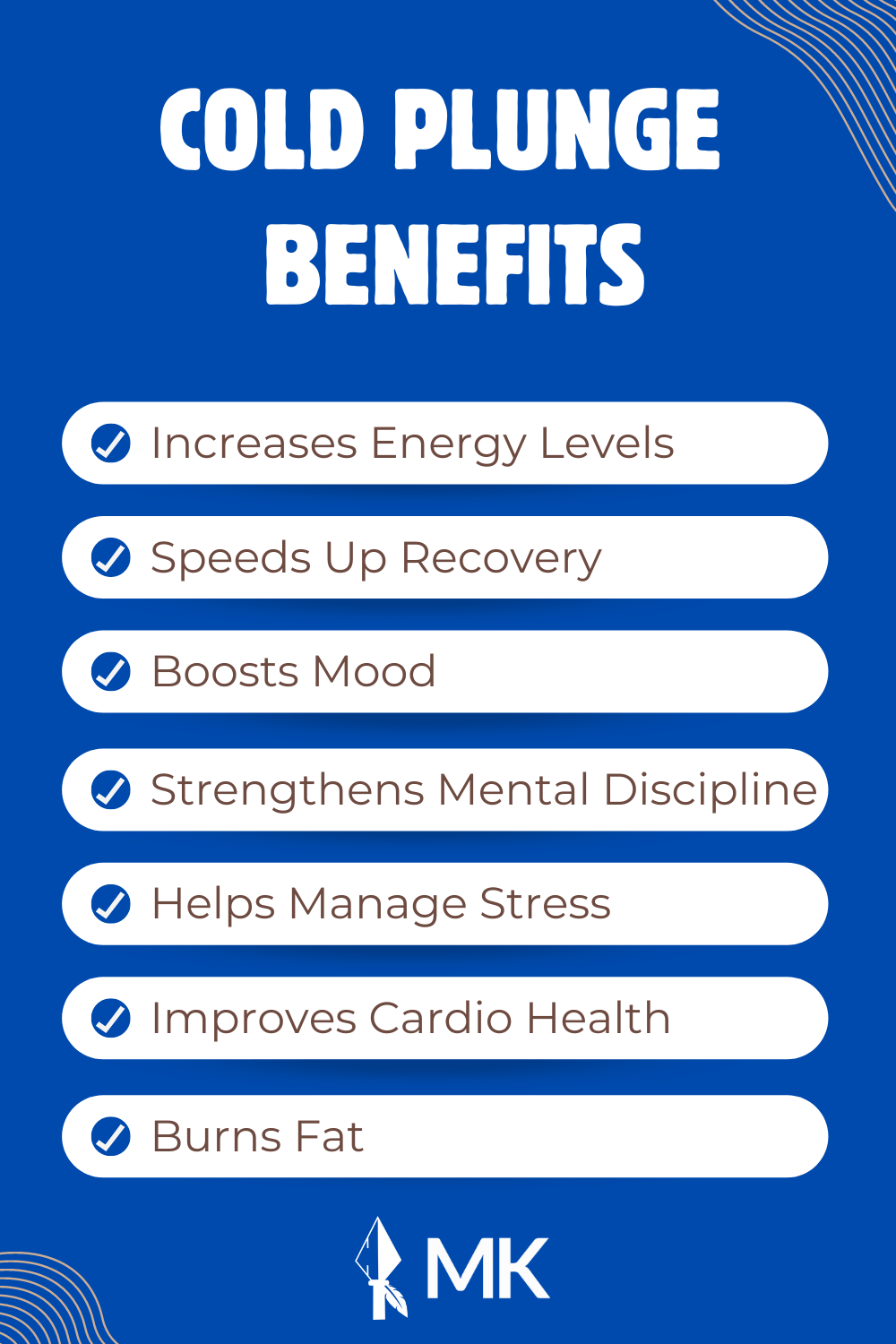
Are cold plunges good for you? The short answer is yes. Cold water immersion works, and it can have a substantial impact on your overall well-being, including your mental health. I’ve personally experienced many of the health benefits detailed in this article, including improved recovery, pain relief, better sleep and more resilience. I’ve also become mentally stronger and better at managing stress.
So I encourage you to give ice baths or cold plunges a try. It does take some getting used to — it took six plunges for me to tamp down that initial fight or flight response — but it’s totally worth it, and I’m glad I decided to give it a try at that biohacking conference in 2021.
When you’re just getting started, you can begin acclimating your body by taking cold showers. The temperature isn’t cold enough to produce all the benefits outlined in this article, but it can be a good first step.
If you’re interested in getting a tub for home use, check out my articles on how to choose a cold plunge and the best cold plunges (one of which only costs $150).

Michael Kummer is a healthy living enthusiast and CrossFit athlete whose goal is to help people achieve optimal health by bridging the gap between ancestral living and the demands of modern society.
Medical Disclaimer
The information shared on this blog is for educational purposes only, is not a substitute for the advice of medical doctors or registered dieticians (which we are not) and should not be used to prevent, diagnose, or treat any condition. Consult with a physician before starting a fitness regimen, adding supplements to your diet, or making other changes that may affect your medications, treatment plan or overall health. MichaelKummer.com and its owner MK Media Group, LLC are not liable for how you use and implement the information shared here, which is based on the opinions of the authors formed after engaging in personal use and research. We recommend products, services, or programs and are sometimes compensated for doing so as affiliates. Please read our Terms and Conditions for further information, including our privacy policy.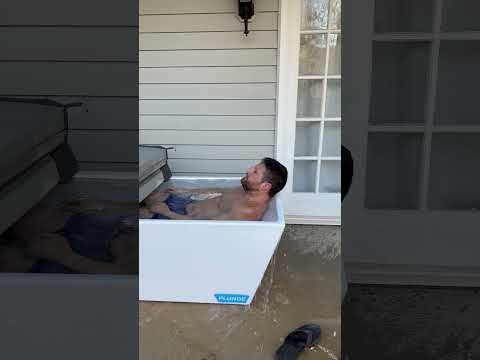
Hi!
I have been cold plunging for 5 months. I now usually go for 6min at 48 degrees which has become pretty easy. My average heart rate is usually around 50 with a low around 44 I have dipped to 39. I have not seen how low others get and I’m wondering if this is a good thing? normal? Any thoughts ? I have very low blood pressure and handle stress well.
Hey Brandi,
I don’t think a low HR is cause for concern. It simply means your body is responding well to the cold stress. Mine tends to be close to baseline as well while I’m in the plunge.
Cheers,
Michael
I’m on day 19 of cold baths. I started with ice in my tub, getting to 55 degrees. I’ve since set up the freezer on my back porch. I’m doing 45 degrees right now hoping to get to 35 degrees on a permanent basis. I’m staying for 6 minutes each dip. My hands and feet are the most sensitive STILL. I am one of those people that was extremely sensitive to cold weather. Hopefully this will help with that as well. Thanks for your article.
You can train your hands and feet separately to be able to handle the cold when you full body ice bathe. I’ve been teaching techniques to groups for about 6 years now, and it really helps people with the Canadian winters we have here.
Hi,
If I put snakes, deadly spiders, or bears in the ice plunge with me in a prison yard surrounded by a rival prison gang and the evil Warden character from Shawshank Redemption, will that increase the sympathetic nervous system and thus potentially increase the hormetic effect?
I guess that depends on how you respond to those threats. If you can manage to regulate your sympathetic response despite all those threats, I could imagine that it would help improve the hormetic effect.
The scientific studies say that these benefits come from 2 hours a day in ice baths… Who is staying in for 2 hours per day? Nobody…
What exact studies are you referring to that say you have to stay in for two hours?
How great that you suggest cold plunging and starting with cold showers. I want to receive the benefits of cold plunging and have been taking cold showers for a couple of months. I will find a good place for cubed ice services so I can start taking ice baths.
I see that you hit the sauna after the cold plunge whereas I have been doing the opposite. Can you share if my strategy is better or worse than yours and why?
I do both, depending on what I’m in the mood for. The traditional way is going from hot to cold but sometimes, I challenge my body by doing the opposite :)
What tool/app are you using to track your sleep in your screenshot in #7?
Hey Vance,
That’s a screenshot from the WHOOP app – see https://michaelkummer.com/whoop-strap-review/